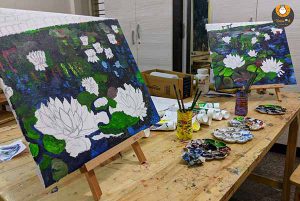You may have heard of this term before, but it can be difficult to understand exactly what impressionism is. This guide on impressionism art class will give you all the information you need to get started with creating your own impressionistic paintings. If you’re looking to add some life and vibrancy to your home décor, then this easy beginner’s guide to impressionism art class will be your best guide on how to begin creating your very own masterpiece!
What is Impressionism?
In art, an impressionist is a painter who creates works that rely on their use of light and color to depict imagery. The term Impressionism was initially used by art critics in France during the 1860s to describe several artists, including Claude Monet, Pierre-Auguste Renoir, Camille Pissarro and Alfred Sisley; these artists all went on to show together at various shows throughout Europe between 1874 and 1886. This movement began as an offshoot of Romanticism, but led to different styles such as Naturalism and Symbolism. Artwork produced during these periods can be classified based on their subject matter—there were pieces focusing on portraits and landscapes (the latter often regarded as symbolic or allegorical). The three biggies are: Representation (meaning images), Abstraction (non-meaning images) & Surrealistic representations. Of course, there are gradations between each style that fall under larger movements (like Symbolism), so choose your art class based upon what you want to learn more about!
About Claude Monet's Japanese Foot Bridge
It’s one of Monet’s most beloved paintings, and it tells a story. The Japanese Foot Bridge depicts a group of Japanese women crossing a bridge over a pond at Giverny. As they’re crossing, Monet paints their reflection on the pond below as well as in other places in his painting. That’s because he wanted to capture them at different points in time instead of all together. In short, he wanted you—the viewer—to feel like you were there with them on that walk across that little footbridge. And that, my friends, is art-making 101. Join us for an art class about Monet next week! We’ll be discussing impressionism and pointillism among other techniques that are still widely used today by artists around the world!

Who was the founder of Impressionism Art Movement?
Impressionist art movement was founded by a group of French artists, including Monet, Renoir, Sisley and Pissarro. The Impressionists sought to capture everyday scenes in paint using vivid colors and quick brushstrokes. They wanted their work—which was sometimes intentionally unfinished—to be seen as more of a snapshot than an accurate representation of a scene. Learn more about where Impressionism began and what it became by reading on.
Where did the name Impressionism come from?
Impressionism was a French art movement that began in Paris around 1874. The name came from critic Louis Leroy, who had judged one of Monet’s paintings as impressionist at an exhibition in Paris. He referred to it as an impression, or a momentary sensation of sight created by light hitting paint on canvas. The French word impression also means an impact, which aptly describes what Claude Monet and other impressionists were trying to do with their art: give viewers a sense of fleeting moments and impressions rather than create lifelike images.
From there, writers such as English novelist James Huneker helped make impression part of everyday speech, describing music that made him feel more like he was hearing it than listening to it. When used in music, impression usually refers to being able to hear how instruments are being played without necessarily knowing (or caring) exactly what they’re playing—the emphasis is more on feeling than exact facts or details.
In everyday speech today though, impression can refer both literally and figuratively; we might call someone’s first visit somewhere their first impression of that place—because we get an overall sense about how we feel about where we just went. It’s all based off those fleeting sensations captured so skillfully by painters like Claude Monet!
Impressionism for kids
What You Need to Know When Pursuing an Impressionism Art Class for Kids: Impressionist art tends to be bold and light, so it’s a great option for kids. Since you don’t have to worry about fine details or shading with impressionism, you can encourage your child to explore his creative side in new ways. It could also inspire them to pursue their own artistic endeavours when they grow up! BrainArt offers Visual Art classes designed to help people get started with basics of light, Shadow, value scale, proportion, perspective, composition & painting, but we also have workshops that teach people how to create art inspired by iconic artists. We run classes on everything from Abstract Expressionism to Pop Art, but our favorite is our series of Faux-Impressionism classes—which means no real canvases are required!















